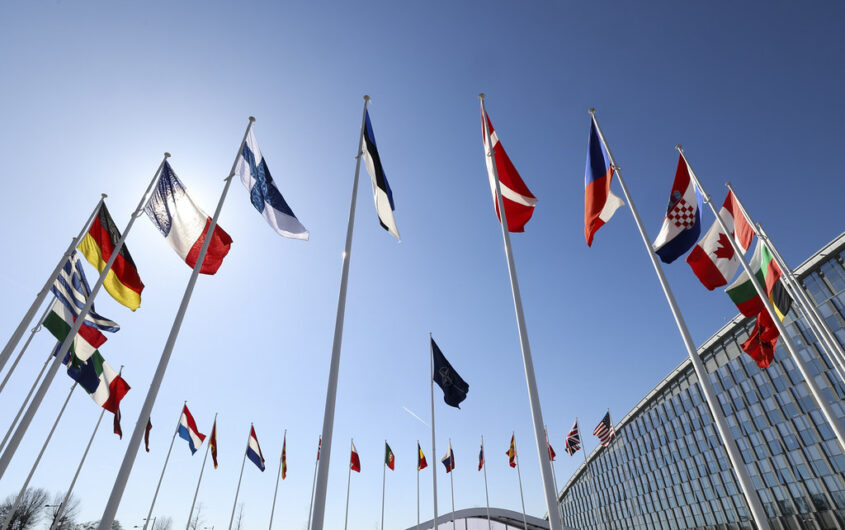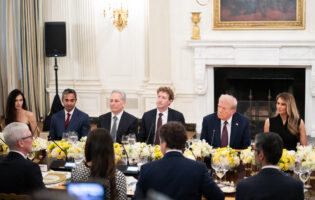
UK Government via Flickr
Seize the Burden

Leonard Schütte
Munich Security Conference
Dr. Leonard Schütte is a DAAD/AGI Research Fellow in March and April 2024.
Dr. Schütte is Senior Researcher at the Munich Security Conference, where he co-edits and contributes to the Munich Security Report and other publications. He holds a PhD from Maastricht University and studied in Cambridge, Oxford, St. Andrews, and Paris. In 2018-2019, he was the Clara Marina O’Donnell Fellow at the Centre for European Reform in London.
Dr. Schütte has published widely on European defense, transatlantic relations, international organizations, and geoeconomics. Recent publications include Munich Security Report 2024: Lose-Lose? (Munich Security Conference, 2024, co-edited with Tobias Bunde and Sophie Eisentraut), Defense Sitters: Transforming European Armies in Times of War (Munich Security Conference, 2023, co-edited with Nicole Koenig), “The Show Must Go On: The EU’s Quest to Sustain Multilateral Institutions Since 2016” (Journal of Common Market Studies, 2023, with Hylke Dijkstra), and “Why NATO survived Trump: the neglected role of Secretary-General Stoltenberg” (International Affairs, 2021).
During his time at AGI, Dr. Schütte will build on previous research to develop a typology of rebalancing options for the transatlantic relationship, with a focus on NATO and Ukraine policy. Whichever way the U.S. elections go, the next U.S. administration will likely shift at least some resources and attention away from Europe, given the multiple parallel threats to the United States, ballooning public debt, and an underperforming defense industrial base. Rebalancing can take many forms, however. Between the extreme ends of the spectrum—with a formal U.S. withdrawal from NATO and abandonment of Ukraine on the one and the status quo on the other end—there are various shades, each with different policy implications. Based on interviews with (former) officials and experts, this project aims to spell out the various scenarios, which in turn can serve to inform European policymaking.
A European Initiative to Put NATO on a Sustainable Footing
Shortly after entering office in 2021, U.S. President Joe Biden exclaimed at the (virtual) Munich Security Conference that “America is back […] The transatlantic alliance is back.” After four acrimonious years under President Donald Trump, the sense of relief among Europeans was palpable. And despite serious disagreements over the U.S. withdrawal from Afghanistan or trade relations, the Biden administration’s leadership in spearheading the Western response to Russia’s full-scale invasion of Ukraine underlined its transatlantic credentials.
However, in hindsight, Biden’s first term may well be considered a final hurrah of the traditional transatlanticists rather than the return to the transatlantic norm. Indeed, we may be at the precipice of an entirely new era in U.S. grand strategy: For the first time in nearly a century, the United States could abdicate its role as security guarantor of Europe. Unlike in past episodes when this specter loomed large over the Alliance, this time, there are influential and capable agents pushing for the caesura. A heterogeneous group among Republicans, in particular, is working to upend the U.S. security strategy toward Europe. Their primary objective is to dramatically reduce the U.S. footprint in Europe by shifting the burden of conventional deterrence onto the Europeans, rather than merely better sharing the burden. If this group prevailed in the intra-party debates within the GOP and Donald Trump wins the presidency in 2024, the consequences for NATO and European security would be vast. But even under a second Biden term, the direction of travel of U.S. security policy is away from Europe. Denying or ignoring this fact means ceding control over the restructuring of the European security order to the United States. Instead, Europeans should get on the front foot and proactively shape this existential process.
The ensuing text buttresses these arguments by, first, outlining the structural, centrifugal forces besetting the transatlantic relationship. The second section elaborates on the plans among a coalition of “burden-shifters” for a new U.S. grand strategy toward Europe. The third section analyzes what the concrete NATO policy under a second Trump term would look like. The fourth and final section then spells out the recommendation that the Europeans launch a Burden-Seizing Initiative to pre-empt a security vacuum in Europe and reframe the burden-shifting debate in collaborative terms. The essay relies on around forty interviews with mostly Republican(-leaning) congressional staffers, former officials, and experts conducted in Washington, DC, in the spring of 2024.
Structural Forces: China, Scarcity, Demography
Structural forces are pulling the United States away from Europe. They do not predetermine policies—structural forces always need agency to materialize—but they will shape U.S. policy, irrespective of parties and personalities in power.
The first structural trend is the geopolitical shift of power to the Indo-Pacific. More than in Europe, there is a growing bipartisan view in the United States that China is “the pacing challenge” and a serious military rival. While there are certainly differences of opinion on the likelihood of a Chinese attack on Taiwan, hardly anyone doubts it is a very real possibility. There is also a much greater urgency in the United States. The 2022 National Security Strategy proclaimed a “decisive decade” in pushing back authoritarian rivals, and Secretary of State Blinken recently echoed views that China could be ready to invade Taiwan by 2027. Experts describe the China challenge more as a “sprint” than a “marathon,” as China may well peak within the next decade and thus has incentives to leverage its current strength. Indeed, China is undergoing a massive military build-up, including of its navy and nuclear arsenal, with its defense spending much closer to that of the United States than widely assumed. The outcome of a war between China and the United States is not a foregone conclusion. Naturally, such perceptions militate in favor of shifting resources to the Indo-Pacific.
The direction of travel of U.S. security policy is away from Europe.
Concomitantly, the second structural trend is the growing scarcity of precisely those resources or at least the perception thereof. The U.S. debt ratio has significantly increased, approaching 100 percent of GDP. Amid higher borrowing costs, the cost of debt servicing now surpasses U.S. defense spending. While not strictly prohibitive, this fiscal context will constrain how much more the United States could spend on its global defense posture. Moreover, the U.S. defense industrial base, like Europe’s, has atrophied and is struggling to ramp up production. In particular, U.S. shipyards are lagging behind in manufacturing what will be a crucial capability for the contest in the Indo-Pacific. As a result, the bipartisan strategic posture commission found that the United States cannot fight two major wars concurrently. The United States will have to prioritize its resources much more than in the past. This fundamentally alters the nature of the transatlantic burden-sharing debate from a fairness- to a functionality-driven logic. While in the past, the debate was about what the equitable distribution of the burden was, it is now increasingly about which U.S. resources are needed elsewhere.
The third structural trend that drives the United States and Europe apart is demographic. The cold-war generation of transatlanticists, many of whom had European heritage, is retiring. Nancy Pelosi’s or Mitch McConnell’s recent retreats from their respective party’s leadership positions are cases in point. The new generation of decision-makers tends to be less reflexively transatlanticist. For example, there was a strong generational divide in voting behavior in Congress on the Ukraine aid package; the older and/or longer-serving, the more likely a Senator voted for the bill. This age gap is also reflected in public attitudes. A recent survey shows that amid a general decline in support for U.S. involvement in world affairs, especially among supporters of the GOP, younger Americans are considerably more skeptical than their older peers. Aside from generational changes, the U.S. society is also becoming much more ethnically diverse, with the share of the population with European heritage steadily declining. Over time, this will shift lawmakers’ foci.
No Longer Eurocentric? The “Burden-Shifters” and a New U.S. Grand Strategy
Since the early twentieth century, U.S. grand strategy toward Europe has been to prevent a single power from dominating the continent by ensuring a favorable balance of power. To do so, the U.S. militarily intervened in both world wars, acted as security guarantor during the Cold War, and has had a forward military presence ever since.[1] Notwithstanding gradually shifting priorities toward the Middle East in the context of the War on Terror and the Indo-Pacific from the 2000s onwards, successive administrations considered European security a core national interest given Europe’s importance as an export market and its resource-richness, relative geographical proximity to the U.S. via the Atlantic, and ideological affinities. But this historic Eurocentricity of U.S. grand strategy is now in doubt.
Long-time observers of the transatlantic relationship may object to the novelty of this looming caesura. They could point to President Obama’s claim that he would be the “first Pacific president” and his administration’s “Pivot to Asia,” the many eulogies held for NATO during President Trump’s term, or calls to “Europeanize NATO” dating back decades.[2] And indeed, the geopolitical and domestic trends have been unfolding for some time, even if they have significantly intensified over recent years. What is new, however, is that there are now willing and capable agents to translate the structural trends into a radical policy change. Unlike in the past, supporters of the transatlantic relationship are on the back foot and are losing sway over the Republican Party in particular, while opponents are considerably more organized than previously. And in Trump, they could have a willing, resentful executor.
Indeed, a heterogenous group—call them “burden-shifters”—of New Right ideologues, former Trump administration officials, Congressmen/women, both realist “prioritizers” of China and “restrainers,” libertarians, and progressives is nascent that is advocating for a complete overhaul of U.S. grand strategy. Notwithstanding significant differences on the use of force, ideology, or China policy, what unites this group is their objective to largely retrench from Europe and shift most of the burden of defending Europe onto the Europeans. This means creating a non-U.S. centered security architecture in Europe, merely acting as an offshore-balancer, and intervening only as a last resort. In other words, this group does not tend to see European allies as “shields of the republic,” or important assets for realizing U.S. grand strategy but as obstacles to that purpose.
The “burden-shifters” differ from the traditional transatlanticists in at least four fundamental assumptions. First, this group tends to deny that U.S. credibility vis-à-vis China is on the line in Ukraine and Europe. Instead, they emphasize that expending military and fiscal resources in Europe means draining capabilities otherwise available to the Indo-Pacific. Rejecting the argument that the theaters are inextricably connected, they tend to compartmentalize the Russia and China threats and make the case for a division of labor, whereby the Europeans predominantly guarantee the security of Europe rather than engaging in what they consider token deployments in the Indo-Pacific.
Second, while not consensual, many consider the military threat posed by China not only potent but also acute. Thus, they argue that the strategy of sequencing—first addressing Russia before focusing on China, which appears to be the Biden administration’s approach—is impossible.
Third, this group also disputes the argument that Russia poses an existential, hegemonic challenge to Europe. Based on their reading of the Russian military performance in Ukraine, they posit that European states could largely defend the continent by themselves, or at least have the latent capacity to do so.
Fourth, unlike traditional transatlanticists, who routinely invoke the common liberal-democratic foundation of the relationship, many proponents of a new U.S. grand strategy are either ideologically indifferent or even hostile toward Europe. For the realist thinkers, common values carry little relevance in the international environment shaped by material power relations. For the New Right, Europe is the epitome of what they dislike—supposedly green, woke, and globalist. For them, Euroskeptics in Hungary, Italy, or France are the natural bedfellows.
Translating Grand Strategic Shifts into NATO Policy
The “burden-shifters” are busy crafting plans on how to translate the shifts in the meta debate into concrete NATO policy to realize the vision of a non-U.S.-centered European security order. Various institutions are preparing the substantive America-First agenda for a would-be President Trump while vetting thousands of potential officials for their political alignment to staff the next administration. Europeans thus cannot again rely on moderate forces constraining the U.S. president or dilettantism and inexperience preventing radical policy outcomes.
In rare positive news for the Europeans, very few advocate for a formal U.S. withdrawal from NATO or the end of the extended nuclear deterrent. Elbridge Colby, for example, cautions against using the threat of withdrawal to put pressure on the Europeans as self-defeating and lacking credibility given remnant U.S. interests in maintaining the European alliance system. In the Heritage Foundation’s Project 2025 manifesto, Chris Miller, former acting secretary of defense, stresses that Europeans can rely on “our nuclear deterrent.”
While in the past, the debate was about what the equitable distribution of the burden was, it is now increasingly about which U.S. resources are needed elsewhere.
Alas, even short of these two extreme outcomes, the repercussions of the new U.S. grand strategy for NATO could be immense. The first casualty could be the sacrosanctity of Article 5 and, concomitantly, the credibility of nuclear assurances. Already during his first term, Trump publicly questioned whether the United States would honor NATO’s collective defense guarantees. His comments on the campaign trail suggest, if anything, that his views on “delinquent” allies have hardened at a time in which a major war in Ukraine significantly increases the gravity of conditioning Article 5. Indeed, Keith Kellog, former National Security Advisor to Vice President Pence and current adviser to Trump, floated the idea of a two-tiered NATO, with a collective defense-deserving core and non-deserving periphery supposedly based on their defense spending.
Europeans also need to prepare themselves for other destructive tactics. Robert O’Brien, Trump’s last National Security Advisor, suggested the next Trump administration could impose tariffs upon those allies not meeting their defense spending commitments. Others allude to the possibility of curtailing allies’ voting power in the North Atlantic Council, appointing a NATO-skeptic as U.S. ambassador to the Alliance, or creating empty chair crises by Trump or other high ranking officials not attending NATO meetings.
Perhaps most consequentially, the “burden-shifters” are developing plans to withdraw U.S. troops and capabilities from Europe. Such withdrawal would serve two purposes: first, redeploying those military assets with military relevance in the Indo-Pacific would strengthen the U.S. deterrence posture vis-à-vis China in light of the perceived scarcity of resources. Second, withdrawing troops would increase European threat perceptions of Russia. This punitive decision is seen by many as the only way to force the Europeans to finally step up and shoulder a much greater burden. The frustration in the United States with Europeans for their paltry defense spending over the past decade(s) is enormous and omnipresent.
Concrete public plans to do so include the Center for Renewing America’s proposal to transform the Alliance into a Dormant NATO. The author Sumantra Maitra argues that the United States should “force a Europe defended by Europeans” with merely a limited U.S. air and naval presence in Europe. A recent policy brief by the Heritage Foundation, in turn, calls for “dramatic changes in the North Atlantic Treaty Organization,” including allies taking “primary responsibility for Europe’s conventional defense [and] in providing military aid to Ukraine.” To do so, the United States should set “clear timelines for the transfer of certain U.S. forces from Europe to incentivize allied investments.” Premised on the “zero-sum tradeoff between reassurance and burden-sharing,” the Cato Institute’s Justin Logan specifies that the United States should resume “the withdrawal of [12,000] U.S. troops from Germany that was initiated under Trump and rescinded by Biden.” He also suggests that NATO’s next Supreme Allied Commander for Europe (SACEUR) should be a European national, not as historically an American. Privately, people mention that the United States should, in the short term, additionally seek to withdraw those almost 20,000 troops deployed to Europe since February 2022. In the medium term, those permanently stationed troops that could be deployed in the Indo-Pacific should be withdrawn.
In terms of capability withdrawal, a recent CSIS study, for example, suggests that a China-First strategy would mean the redeployment of the UK-based F35 squadrons, Spain-based destroyers, long-range fires such as ATACMS, air and missile defense, and critical enablers like airlift and munitions. Jeff Rathke and Theresa Lütkefend also identify air and missile defense, suppression of enemy air defense, and intelligence, surveillance, and reconnaissance as “high-demand, low-density capabilities.”
The very real danger that follows from such withdrawals is that they could create a security vacuum in Europe. If burden-shifting becomes “a unilateral exercise of power driven by American interests,” as propagated by some, an uncoordinated and rapid retrenchment could critically undermine the European ability to sustain combat operations and thus the deterrence posture vis-à-vis Russia.
Toward a European Burden-Seizing Initiative
It is of course not pre-destined that this worst-case scenario materializes. Three major factors will shape the future of U.S. grand strategy toward Europe. First, an overhaul of U.S. grand strategy toward Europe is far more likely under a President Trump than Biden, given the former’s deep-seated animosity toward alliances in general and NATO in particular. Even then, it is not yet clear which foreign policy current will prevail in the intra-GOP debate and actually have influence over the notoriously unpredictable Trump. The traditional transatlanticist establishment in favor of a strong U.S. presence in Europe remains powerful, even if they appear on the back foot as the voting record both in the House and Senate on the Ukraine aid bill testifies to. More than half of House Republicans (112 against versus 101 in favor) voted against the bill, while more than half of Republican Senators (26 to 22) voted against the first version of it (once the House passed the bill, 31 Republican Senators voted for it and 15 against). A declining share of Republican and Republican-leaning voters also view NATO favorably. Trump’s appointments of senior national security positions, should he win in November, will be the first real indication of the balance of power between the different tribes. And even if the “burden-shifters” prevail, they will still encounter serious practical obstacles to realizing their vision. Troop and system withdrawals, for example, have proven difficult to realize in the past, requiring not only funds that need to be granted by Congress but also base capacity elsewhere.
Second, it will also depend on how the geopolitics of the Indo-Pacific evolve. The higher the threat perceptions, the greater the pressure to shift forces and capabilities. In the event of a contingency, or the tangible threat thereof, not just a President Trump but also a President Biden would likely feel compelled to immediately shift useful resources into the region.
Finally, it will critically depend on what the Europeans do. Continued lackluster efforts by European “defense sitters” could provide further fuel to fire among the Republicans. But Europeans have agency to shape the debate if they seize the initiative. The primary task for European policymakers is to pre-empt the risk of a security vacuum. To do so, European NATO allies should proactively launch a plan on how to replace the bulk of those U.S. military assets that have military relevance in the Indo-Pacific in the near to medium term. The overriding objective would be to pre-empt the risk of a security vacuum and reframe the burden-shifting debate as a collaborative rather than unilateral endeavor. Call it a European Burden-Seizing Initiative.
This European Burden-Seizing Initiative would have a material, institutional, and communicative dimension. First and foremost, it entails a concrete timeline for when and how Europeans will replace critical U.S. assets of military relevance in the Indo-Pacific. The military requirements between the land-centric European theater and the maritime-centric Indo-Pacific theater certainly differ, which means that select U.S. capabilities, primarily ground capabilities like heavy tanks but also older aircraft like F16s, could remain deployed in Europe. But there are nonetheless critical capabilities that are required in both—though the extent to which is contested. The essence of this initiative then would be to shift foci from abstract defense spending figures—though European defense spending will certainly have to increase—to tangible capabilities. It is undeniable that in light of the state of European land forces and European defense industrial integration, replacing these assets even over the medium term is a Herculean task. But resignation in the face of the magnitude of the task is not an option.
Second, the institutional dimension of the European Burden-Seizing Initiative pertains to the format within which such an initiative should be launched and the necessary reforms of both NATO and the EU to realize it. By definition, it should be the European NATO allies that assume the leadership role in Europeanizing NATO. French President Macron suggested in his recent Sorbonne speech that he intends to use the next meeting of the European Political Community in July to informally discuss ways to strengthen the European pillar of NATO. This appears like a reasonable first step to gather political momentum, though discussions should subsequently involve the NATO defense planners and U.S. counterparts.
A significantly greater European role in conventional deterrence and defense should also be reflected in NATO’s command and control structure. For instance, Luis Simon, Daniel Fiott, and Octavian Manea propose that the Europeans shoulder greater responsibility in NATO’s operational and component commands in Europe.
The essence of this initiative would be to shift foci from abstract defense spending figures—though European defense spending will certainly have to increase—to tangible capabilities.
Realizing such an ambitious initiative will also necessitate close cooperation between NATO and the EU. As we at the Munich Security Conference argued in a report last year, European defense cooperation can only be transformed if the EU becomes the strategic enabler for NATO. It should be the European NATO allies’ role, drawing on NATO staff’s expertise, to set the procurement priorities for the European Burden-Seizing Initiative. The EU can then use its financial and regulatory tools to incentivize European cooperation to procure these capabilities in the most efficient way and ramp up European industrial capacity. And it requires creative thinking on how to significantly better fund European defense, including on European defense bonds.
Third, the initiative would serve a communicative purpose. The point of bundling several efforts to Europeanize NATO under the umbrella of the European Burden-Seizing Initiative is to make it politically sellable. Europeans have been on the back foot in debates in DC over the future of NATO for years. It is time to get onto the front foot to transform the image of Europeans in the United States as spoiled children to that of determined adults. Needless to say, this requires a much more concerted effort among the Europeans in DC, where Europeans often work disjointedly or even against each other.
Conclusion
The risk of U.S. abandonment of Europe is real. Neither a contingency in the Indo-Pacific nor a resentment-driven decision by Trump, or a Trumpist in the future, can be ruled out. And even short of such an outcome, U.S. retrenchment from Europe over time is likely given the centrifugal forces pulling the United States away from the old continent. Europeans should not seek to halt this trend, which would likely aggravate rather than improve transatlantic relations. Instead, it is high time to seize the initiative before it is too late and the United States presents Europe with a fait accompli. Instead, something akin to the European Burden-Seizing Initiative offers the opportunity to collaboratively put NATO on sustainable footing and dramatically reduce Europe’s vulnerability to the vagaries of U.S. domestic politics and geopolitical upheavals. Only then can we trust that “the transatlantic alliance is back” for years and decades to come.
[1] Linda Desmaele, Europe’s Evolving Role in U.S. Grand Strategy: Indispensable or Insufferable? (Oxon and New York, NY: Routledge, 2024).
[2] Jolyon Howorth and John T.S. Keeler, Defending Europe (New York, NY: Palgrave Macmillan, 2003).
Supported by the DAAD with funds from the Federal Foreign Office (FF).








